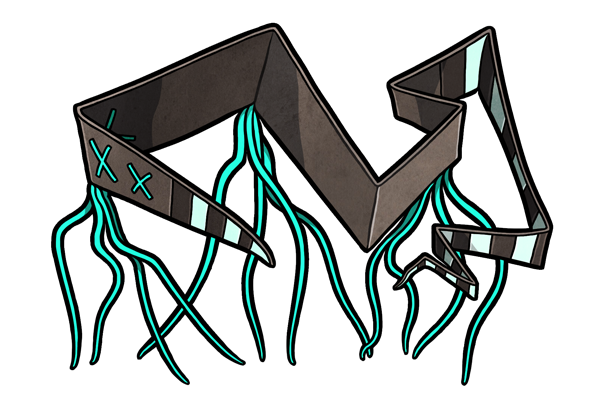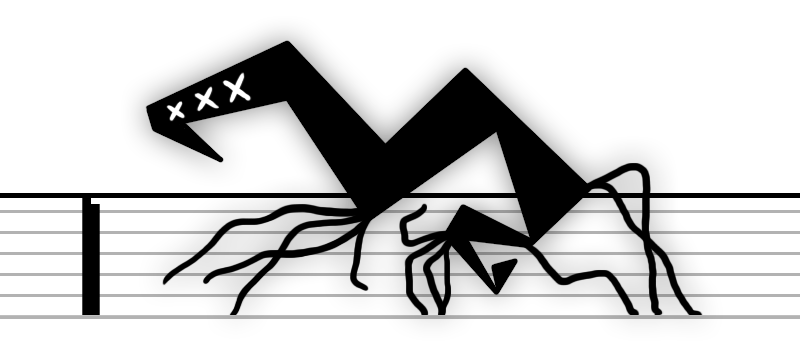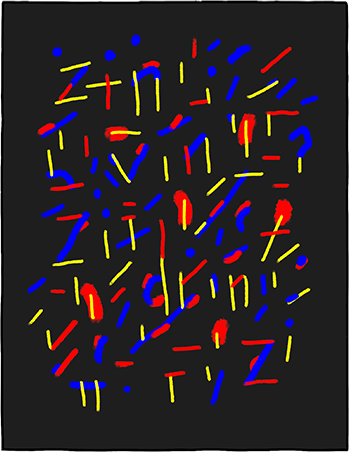

zinvinzidrinzi
the tenants
prefix zinvinzi suffix drinzi
inginging rig bexigbgigbigbig
physical appearance
The zinvinzidrinzi /zɪnˈvɪnzəˌdɹɪnzi/ is a grey and cyan colored, two-dimensional stranger that appears inside walls. Though embedded within a solid plane (and doing so without overt destruction of the space in which it appears), the zinvinzidrinzi is not holographic, and feels papery or paint-like when touched. Its size varies depending upon the size of the wall in which it appears, as does its number of legs (with most individuals possessing two to six sets of four legs). The zinvinzidrinzi's odor is like vinyl, but noticeable only at a distance of less than several inches. It leaves this smell behind on the hand of anyone who touches it, but does not taint its environment with this odor.
The zinvinzidrinzi's form is highly susceptible to changes within its environment. Prolonged exposure to temperatures above 75°F causes it to dry out and flake apart, while moisture makes it grow soggy and soft. It is as flammable as paper, and has only inconsequential regenerative ability, with tears in its form closing up only by millimeters over several years.
The zinvinzidrinzi's voice varies as much as do the people in the city in which the stranger dwells. It tends to refrain from speech.
Telloxi canvoritanx de de telcannox. Cano votanx?

environment and generation
The zinvinzidrinzi appears within the wallsҸ of large buildings, preferring places with daily shifts in activity as opposed to prolonged human contact. Offices, museums, and malls are common sites for a zinvinzidrinzi infestation, while apartments, hotels, police stations or dormitories are not.
The zinvinzidrinzi blinks into existence with only a small tap. Its initially legless body cracks the wall in 0.7% of instances, although these cracks are hairline-thin. When it first appears, the zinvinzidrinzi possesses a smaller width, but becomes slightly thicker over time. Its legs grow downward over a span of one to seven hours. Once these legs reach the bottom section of the wall, the zinvinzidrinzi rapidly grows active.
behaviour and effects
The zinvinzidrinzi is an energetic, if flighty, stranger. Limited in its movements, it is unable to leave the walls in which it appears. Only 34% of individuals are able to turn upon hitting an intersection, with the majority of zinvinzidrinzi instead being restricted to the plane within which they generate. In addition, larger zinvinzidrinzi are less likely to be able to turn, while smaller individuals are considerably more mobile.
The zinvinzidrinzi grows more restless when the wall around it is tapped, and enters a dormant state only in the complete absence of any stimulus. The zinvinzidrinzi's fast movements damage the walls around it, but only over the span of many decades, and not to the extent that structural integrity tends to be compromised, except in the case of very dilapidated乁 buildings.
Although social, the zinvinzidrinzi is not capable of touching or moving past its companions. Regardless, it does make continuous attempts at closeness with its companions, with a zinvinzidrinzi being more likely to be near another zinvinzidrinzi than by itself. More socially inclined individuals, however, do experience a decrease in physical health as a result, their motions turning shaky and their bodies more brittle, with even rough patches in the wall breaking them up and severing their limbs.
The zinvinzidrinzi is normally silent or close-to-silent, but groups do speak to one another in a human-like voice when the building in which it dwells becomes devoid of tenant activity for more than several weeks at a time.
Despite the restlessness that characterizes its typical movements, the zinvinzidrinzi grows still as a defensive mechanism when violent events occur within its vicinity. Aggressive actions between human beings appear to taint the area for the zinvinzidrinzi, and following such an occurrence, the strain's movement ceases altogether for several weeks. The zinvinzidrinzi displays a similar defensive response to audio of screams, and shivers following prolonged exposure to such audio. Its stability declines noticeably following this exposure.
interactions with sensitives
The zinvinzidrinzi's containment within walls makes it difficult to interact with directly, but physical contact can be achieved when a sensitive partially tears down the walls in which the stranger lives, taking care to do so bit-by-bit so as not to frighten the easily-disturbed zinvinzidrinzi or destroy its body in the process.
Physical contact with the zinvinzidrinzi causes repetitive and involuntary motions, such as a clenching or unclenching of the hand, a rotating of the finger, a shaking of the arm, or a turning of the wrist. These motions tend to be localized to the arms and legs, but facial muscle spasms or clenching of the jaw is observed in a small minority. These tics persist for ten to seventeen months, growing weaker (but not disappearing completely) during sleep, and with recurrent flare-ups in the years that follow onset.
These muscle spasms occur in tandem with short-term memory problems, although the extent of these issues varies. Some individuals display only minor difficulties remembering small details about their lives, and become unable to recall the exact sequence of events that take place during a day, for example, or displaying difficulty re-telling the narrative of short stories or movies. Other individuals, however, are more severely affected, to the extent of being unable to count to ten or finish their sentences, let alone function in the world.
When killed by a sensitive, the zinvinzidrinzi's body becomes reflective, a response that does not occur during death by other means.
Upon witnessing the violent death of a sensitive (whether due to predatory strangers, murder at the hands of another sensitive, or any other cause), the zinvinzidrinzi vibrates for less than half a minute before breaking apart into large fragments.
aging and death
Although the zinvinzidrinzi tends to experience wear-and-tear over the course of its life, under ideal circumstances, it does not age, but instead dies without warning. When, and only when, the zinvinzidrinzi dies near a sensitive, it does so with a deafening grinding sound. Because of this response, combined with the zinvinzidrinzi's hidden habitat, most sensitives become aware of its existence only upon the stranger's death.
Following its death, the zinvinzidrinzi's corpse spreads out, diffusing into powder, its edges blurring. Despite this diffusion, the zinvinzidrinzi's body does not decompose. While living zinvinzidrinzi are incapable of contact with one another, individuals are not prevented from touching their dead companions, and do with a shuddering gasp.ᴟ
ᴟ Yes! The beast cried out. Finally, I can place my hands upon you, my friend. But I see that you've already gone someplace, someplace else...
Ricarda Sharpe Shearer. Muralia Lost.





